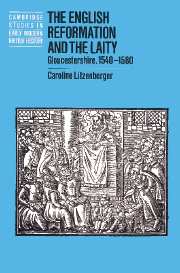Book contents
- Frontmatter
- Contents
- List of figures
- List of tables
- Acknowledgments
- Abbreviations and conventions
- Introduction
- 1 Setting the scene
- 2 Gloucestershire in the 1530s
- 3 The new diocese of Gloucester (1540–1546)
- 4 The advent of Edwardian Protestantism (1547–1553)
- 5 A return to the old religion (1553–1558)
- 6 The early years of Elizabeth's reign (1559–1569)
- 7 The clarification of the religious settlement (1570–1580)
- Conclusion
- Appendix A Sources and methodology
- Appendix B Results of wills analysis
- Appendix C Parish finances
- Bibliography
- Index
- Cambridge Studies in Early Modern British History
Introduction
Published online by Cambridge University Press: 23 November 2009
- Frontmatter
- Contents
- List of figures
- List of tables
- Acknowledgments
- Abbreviations and conventions
- Introduction
- 1 Setting the scene
- 2 Gloucestershire in the 1530s
- 3 The new diocese of Gloucester (1540–1546)
- 4 The advent of Edwardian Protestantism (1547–1553)
- 5 A return to the old religion (1553–1558)
- 6 The early years of Elizabeth's reign (1559–1569)
- 7 The clarification of the religious settlement (1570–1580)
- Conclusion
- Appendix A Sources and methodology
- Appendix B Results of wills analysis
- Appendix C Parish finances
- Bibliography
- Index
- Cambridge Studies in Early Modern British History
Summary
In the summer of 1551, in the middle of the reign of Edward VI, the churchwardens of St Michael's, Gloucester, paid two labourers 4s ‘for the cariege of yerthe owte of the churche’ to lower the floor where the altar had stood and prepare the place for the new wooden communion table required by Edwardian Protestantism. Two years later St Michael's installed a new altar, having paid 6s 8d to ‘the halyer for xiij lodes of earthe for [raising] the said altur’ as required by the return to Catholicism under Mary I, Edward's half-sister and successor. Here we see a local parish responding promptly and conscientiously to the requirements of the successive religious policies of the Crown. This return to Catholicism may have been the most abrupt and dramatic policy shift, but since the early 1530s official policy in England had swung back and forth between various forms of the old and the new religion. In that earlier decade, the break with Rome, the prohibition of selected traditional beliefs and practices, and the dissolution of the monasteries signalled a move away from the theology and discipline of the pre-Reformation church. Meanwhile, the centrality of scripture in preaching, worship and piety determined the nature of the newly emerging Henrician Church. This was not, however, the beginning of a steady move toward Protestantism akin to the inexorable rise of the waters behind a dam after the flood gates have been closed, but more like the ebb and flow of the waters of an ocean, at least until the 1570s. Hence, the religious world of the English laity was periodically disrupted, sometimes in sudden and wrenching ways. One month people were being urged to make pilgrimages to shrines which housed holy relics; the next month the relic was gone.
- Type
- Chapter
- Information
- The English Reformation and the LaityGloucestershire, 1540–1580, pp. 1 - 8Publisher: Cambridge University PressPrint publication year: 1997



